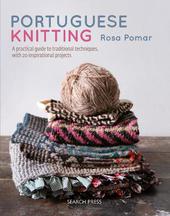
|
Portuguese Knitting: A Historical & Practical Guide to Traditional Portuguese Techniques, with 20 Inspirational Projects
Hardback
Main Details
| Title |
Portuguese Knitting: A Historical & Practical Guide to Traditional Portuguese Techniques, with 20 Inspirational Projects
|
| Authors and Contributors |
By (author) Rosa Pomar
|
| Physical Properties |
| Format:Hardback | | Pages:160 | | Dimensions(mm): Height 260,Width 204 |
|
| Category/Genre | Knitting and crochet |
|---|
| ISBN/Barcode |
9781782217213
|
| Classifications | Dewey:746.432043 |
|---|
| Audience | |
|---|
| Illustrations |
185 Illustrations, color
|
|
Publishing Details |
| Publisher |
Search Press Ltd
|
| Imprint |
Search Press Ltd
|
| Publication Date |
20 January 2020 |
| Publication Country |
United Kingdom
|
Description
More than just a history book or a handicraft manual, Portuguese Knitting is a journey into Portugal's knitting heritage. Traditional patterns and techniques are brought up to date in the form of beautiful modern pieces such as socks, hats, shawls, cowls, pot holders and leggings. Portuguese knitting differs from regular knitting in the way the wool is held; it can either be passed through a special Portuguese knitting pin attached to the knitter's clothes, or looped around the neck and then over a finger. Easy-to-follow instructions and clear illustrations allow beginners or more experienced knitters to recreate historical pieces in an original, contemporary way. You can make the projects as they are shown, or use other colours to create your own unique and original gifts.
Author Biography
Rosa Pomar learned to knit at the age of seven and never stopped. As a child, she knitted mainly dolls and her family found it difficult to tear her away from her knitting needles. She took courses in medieval history, then subsequently in illustration at the School of Visual Arts in Nova Cirque. As the author of one of the oldest Portuguese blogs, www.aervilhacorderosa.com, she frequently addresses the subject of traditional Portuguese textiles. She carries out research in this area, especially in the field of wool, travelling around the country to visit shepherds and spinners. In 2008, she created Retrosaria, a store dedicated to the sale of fabrics and materials for knitting and sewing (www.retrosaria.rosapomar.com). Since 2009, she has created several new textile techniques, always finding ways of bringing the traditional Portuguese knitting methods into contemporary pieces.
ReviewsThis is a journey into Portugal's knitting heritage. Portuguese knitting differs from regular knitting in the way the wool is held and these instructions are clear and easy to follow. Beginners or experts can recreate historical pieces brought up-to-date in an original and contemporary way. * Machine Knitting Monthly * If you have never seen Portuguese knitting in action, it's well worth finding a video to see. It is absolutely fascinating! This book should be on every knitters wish list. It is filled with beautiful projects, 20 in total, and they all have stunning designs and beautiful colour choices. The beginning of the book gives an in depth history of Portuguese knitting, with some interesting pictures. There is advice on pins, needles and most importantly yarn. The projects themselves are varied, including hats, bags, leggings and even a pillow, that all demonstrate how versatile and useful Portuguese knitting can be. There are several techniques, stitches, hints and tips to help you along the way and you can even embroider your finished designs to give them a personal and individual flair. I adored the Lace Collar, it's very vintage and really beautiful. -- Tracy Shephard * Amazon * Until I read this book I hadn't thought of Portugal as having a knitting tradition and, indeed, the author says that this is the first comprehensive study of the subject. The book starts with a historical review, setting Portugal in the context of the development of European knitting. The following section examines traditional equipment and materials and describes a range of traditional knitted artefacts including socks and stockings, hats and caps, jumpers, purses and rugs. The traditional technique involves tensioning the yarn around the neck or through a hook or pin on the left shoulder, with the yarn manipulated by the left thumb. This makes purl the easiest stitch and the section on techniques provides very clear instructions. There are 20 projects included, based on traditional Portuguese knitted items and most of them knitted in the traditional way, from the back in purl. The book is well illustrated with photographs and diagrams and with a comprehensive bibliography. It is a rewarding read for anyone interested in traditional knitting. Originally written in Portuguese, the translation is clear and very readable. -- Hilary Miller * The Journal for Weavers, Spinners & Dyers *
|